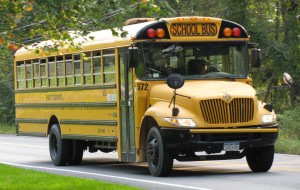 The town where I live – Ithaca, NY – had six inches of snowfall this week during a school day. The snow storm prompted a vigorous debate among a group of moms about whether children should wear safety belts on school buses.
The town where I live – Ithaca, NY – had six inches of snowfall this week during a school day. The snow storm prompted a vigorous debate among a group of moms about whether children should wear safety belts on school buses.
My children’s school district does not encourage kids to wear seat belts on the bus. I’ve heard directly from two separate bus drivers that the belts don’t improve kids’ safety. But my mom friends and I wondered, how can that be? Why are seat belts so important to wear in a passenger vehicle, but not on a bus?
So I went digging for evidence and found interesting information on school bus safety. It turns out, people have been debating for decades whether kids should wear safety belts on buses.
I found comprehensive reviews of the literature on this topic in two places. The National Highway Traffic Safety Administration has reviewed the evidence on school bus seat belts several times, most recently in 2002. The Administration found that lap belts did not improve the safety of kids in frontal-impact accidents. Instead, children on school buses are protected by “compartmentalization.” Essentially,
school bus seats are spaced closely together and have energy-absorbing seat backs to protect kids without seat belts.
A second large review was conducted in 2010 by the University of New South Wales in Australia, and includes data from across the globe. This review found that:
- Most injuries of school bus passengers occur when students are entering or leaving the bus.
- Frontal crashes are the most common type of accident that cause injury to kids on school buses. Rollover crashes are less common, but can result in severe injuries.
- Lap-only seatbelts often cause serious neck injuries in frontal crashes.
- Lap-shoulder seatbelts provide better protection against head and neck injury, but only if they are sized properly. There are new bus seatbelt systems with an adjustable shoulder strap, but there are not sufficient data to determine whether they are effective.
After reviewing the data, I feel more comfortable with the fact that my son does not wear a seat belt on the school bus. I also found an additional information source very reassuring: Another federal data review definitely determined that school buses are much safer than passenger cars and walking for transporting kids to and from school.
As a parent, it can be difficult to send your child off on a school bus with a driver whom you don’t personally know. But the evidence shows, school buses are in fact the safest way to transport kids to school, even without seat belts.



I think students should wear seat belts because the bus driver wear seat belts and when something do happen probale the bus driver might live.
I have been driving a school bus for the last 15 or more years in upstate NY. This year is my first year of really working with my students on wearing a seatbelt. This is what I have found that could make a big difference if there was an accident.
When riding the bus, children have a tendency to want to stand up, or turn themselves around in their seats to engage with students behind them while kneeling in their seats facing the rear of the bus rather than the front. Worse yet, they like to turn themselves into the isles and literally hang out totally unprotected. If there were an accident, this is when a child could be seriously injured and thrown around the bus.
Now that they are encouraged to wear the seatbelt,they are not standing, not in the isles and sitting properly in their seats. I find that this practice not only keeps them safely seated,but minimizes the distractions on the bus and makes an accident that much more less likely. As a schoolbus driver we cannot force a student to wear a seatbelt, only encourage it. I am pretty sure the results of the research are based on the facts of the structure of the bus and its space. However, if the students are not using the space as it is intended to be used( not sitting in the seat properly or standing in the isles) then how can they be protected by it? If they use the lap belt properly, they are more likely to sit properly in the seats and this will in fact keep them safe.
of similar interest is this TED talk on the efficacy of carseats vs. lap belts by economist steven levitt: http://www.ted.com/talks/steven_levitt_on_child_carseats
it is entitled surprising statts about child carseats. he reviews the available data and conducts his own experiments to investigate.